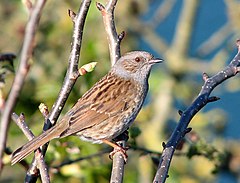Dunnock
| Dunnock | |
|---|---|
 |
|
| Scientific classification | |
| Kingdom: | Animalia |
| Phylum: | Chordata |
| Class: | Aves |
| Order: | Passeriformes |
| Family: | Prunellidae |
| Genus: | Prunella |
| Species: | P. modularis |
| Binomial name | |
|
Prunella modularis (Linnaeus, 1758) |
|
 |
|
| Global range Year-Round Range Summer Range Winter Range | |
The dunnock (Prunella modularis) is a small passerine, or perching bird, found throughout temperate Europe and into Asia. Dunnocks have also been successfully introduced into New Zealand. It is by far the most widespread member of the accentor family, which otherwise consists of mountain species. Other common names of the dunnock include the hedge accentor, hedge sparrow, or hedge warbler.
The name "dunnock" comes English dun (dingy brown, dark-coloured) and the diminutive ock, and "accentor" is from post-classical Latin and means a person who sings with another. The genus name Prunella is from the German Braunelle, "dunnock", a diminutive of braun, "brown", and the specific modularis is from Latin modulus, "melody".
A European robin-sized bird, the dunnock typically measures 13.5–14 cm in length. It possesses a streaked back, somewhat resembling a small house sparrow. Like that species, the dunnock has a drab appearance in order to avoid predation. It is brownish underneath, and has a fine pointed bill. Adults have a grey head, and both sexes are similarly coloured.
Dunnocks reside in the more mild western and southern parts of the globe, inhabiting much of Europe including Lebanon, northern Iran, and the Caucasus. Dunnocks were successfully introduced into New Zealand during the 19th century, and are now widely distributed around the country and some offshore islands. Favourite habitats include woodlands, shrubs, gardens, and hedgerows.
The main call of the dunnock is a shrill, persistent tseep along with a high trilling note, which betrays the bird's otherwise inconspicuous presence. The song is rapid, thin and tinkling, a sweet warble which can be confused with that of the Eurasian wren, but is shorter and weaker.
Dunnocks are territorial and may engage in conflict with other birds that encroach upon their nests. Males sometimes share a territory and exhibit a strict dominance hierarchy. Nevertheless, this social dominance is not translated into benefits to the alpha male in terms of reproduction, since parternity is usually equally shared between males of the group. Furthermore, members of a group are rarely related, and so competition can result.
...
Wikipedia

